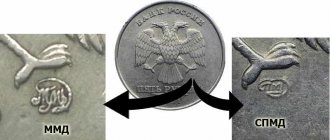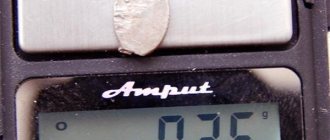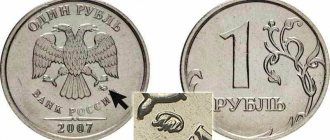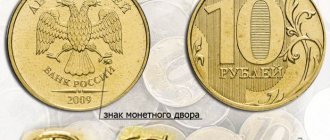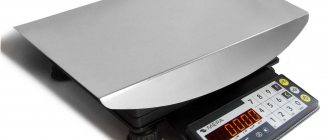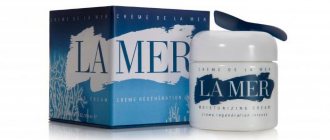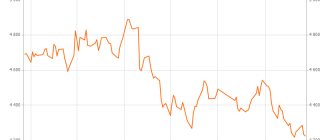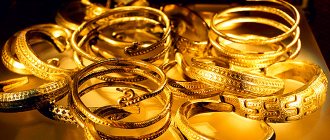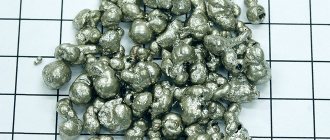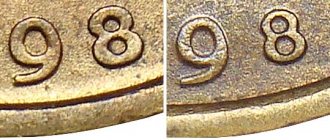How often are 10 rubles from 1901 counterfeited?
The 10 ruble coin, issued under the last Russian Tsar, is one of the most frequently counterfeited. Immediately after the revolution, the Bolsheviks needed money, and the country was also in debt to European states. Gold coins of the new type were not accepted abroad, so the Bolsheviks decided to use a stamp partially preserved after the revolution. With its help, a fairly large number of counterfeit royal chervonets were issued.
With the development of technology and the emergence of online stores, many Chinese counterfeits have appeared. The banknotes are made with high quality, with a high degree of reliability, but they do not contain gold. In addition, such coins are completely legal, because... are positioned by the seller as replicas in “imitation of antique style.”
Where can I buy
In addition to historical significance, such imperial banknotes also have significant financial value. Due to this, many collectors try to get as many different versions of Nikolaev coins as possible. Others use these products as an investment vehicle.
To purchase similar chervonets, you can use various online catalogs or visit antique shops where you can choose the option you like. In addition, it is possible to buy gold chervonets through auctions. Most products are sold at the price of their gold mass.
You can buy a coin at special auctions
What's worth knowing
Tsar's chervonets were minted between 1898 and 1911 and bore the profile of the last Russian Tsar, Nicholas II. It is interesting that not all domestically produced banknotes bore portraits of reigning emperors and empresses. Thus, under Paul I, a decree was introduced (later repealed) banning the depiction of the Tsar’s face on printed money.
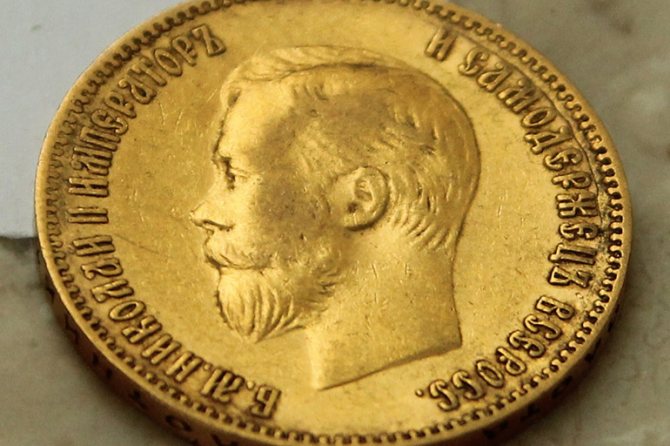
The Tsar's chervonets had the profile of Nicholas II.
Chervonets were produced by the St. Petersburg Mint, whose mintsmeisters (chiefs) at that time were Felix Zaleman (1899 - 1901) and Alexander Redko (1901 - 1905). Their initials were engraved on the edge of the coin.
Original coins are characterized by a deeper imprint of “1” in the year of issue, because the machine displayed the year with great effort on one, and not on other numbers.
How many coins were issued at court?
Statistical data on the amount of money issued are given for the period for 1901.
| Copper | Circulation |
| 1 kopeck | 30 million coins |
| 2 kopecks | 20 million coins |
| 3 kopecks | 10 million coins |
| Silver | Circulation |
| 5 kopecks | 5.8 million coins |
| 10 kopecks | 15 million coins |
| 15 kopecks | 6.7 million coins |
| 25 kopecks | There are no exact numbers, but the batch was small |
| 50 kopecks | 412 thousand coins |
| Gold | Circulation |
| 5 rubles | 7.5 million coins |
| 10 rubles | 2.4 million coins |
How are counterfeits made?
The Russian counterfeit market produces fakes by casting a circle from metal. A stamp copied from genuine banknotes subsequently leaves a mark on it. For authenticity, money is made from the same metal as the original, but the desire for the greatest similarity leads to the fact that there is more gold in the fake than in the Nicholas Chervonets.
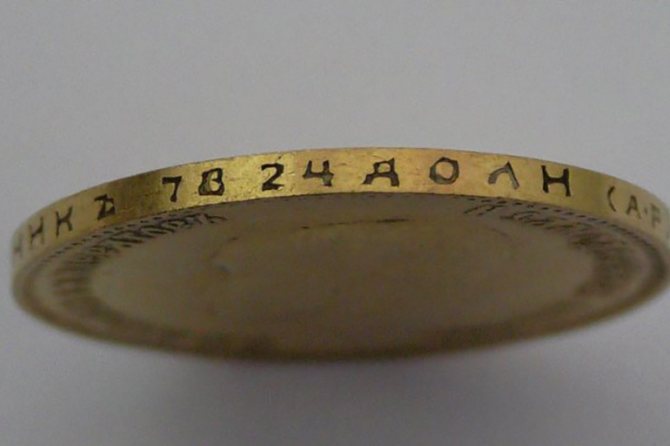
Counterfeit coins were cast from metal.
Who ruled in 1901 and what coin denominations were issued under him
End of the 19th century and the beginning of the 20th century. were difficult and controversial in the history of the Russian Empire. In addition to an active foreign policy, Nicholas II was engaged in changing the economic situation within the country. So, in 1892, he appointed S.Yu. to the post of Minister of Finance. Witte, who developed and implemented financial reform. Its goal was to bring all banknotes to a single rate: paper money, copper and silver coins were exchanged for gold.
Thanks to these changes, the financial system became stable, and the money minted during that period embodied the words “reliability” and “high value.”
Under Nicholas II in 1901, many coins of various denominations were issued.
| Copper | 1 kopeck | 2 kopecks | 3 kopecks | |||
| Silver | 5 kopecks | 10 kopecks | 15 kopecks | 25 kopecks | 50 kopecks | 1 ruble |
| Gold | 5 rubles | 10 rubles |
In the same year, several small denomination coins were issued for the Principality of Finland, which was part of the Russian Empire.
| Copper | 1 penny | 5 pennies |
| Silver | 25 pennies |
Methods for determining the authenticity of a ten-ruble coin of 1901
Nowadays, interest in numismatics has increased greatly, which has led to a flood of the market with copies of royal (and other) coins. Now the offer to purchase rare banknotes and add to your collection can be heard not only at auctions, but also at the market or in a shopping center. To avoid becoming a victim of scammers, you need to know how to distinguish completely clumsy fakes. To make a fake chervonets of higher quality, you cannot do without an examination.
Tooth test
A method familiar to everyone from movies and books with pirates: bite a coin, and if it is original, a mark will remain. You can try, but there are a number of disadvantages:
- money is minted not only from hard alloys, for example, on lead the mark will remain the same as on gold;
- tooth enamel may be damaged;
- not hygienic.

In addition to the above disadvantages, this method does not provide a complete guarantee of authenticity.
Special ringing
The essence of the test is to toss a chervonets. When it falls on a hard surface, listen to the sound.
For such an experiment to be successful, you need to have excellent hearing and know what kind of ringing the original coin makes. You can take a genuine banknote and one that is in doubt, throw it in, and compare it. But few people will agree to such an experiment, during which confusion may occur.
Magnetic properties of the coin
To check, you will need a magnet that is applied to the banknote. If it attracts, then it is fake. Gold does not have this property.
This was the case before, but now counterfeiters have gone further and almost always make counterfeit money from tin, aluminum with a piece of copper.
Such money is also not attracted by a magnet.
Gold plating test
When counterfeiting, gilding is used, passing it off as a noble metal. To check, you should carefully run the needle along one side of the chervonets. This will allow you to remove the thin top layer of gilding and see the true material from which the banknote is made.
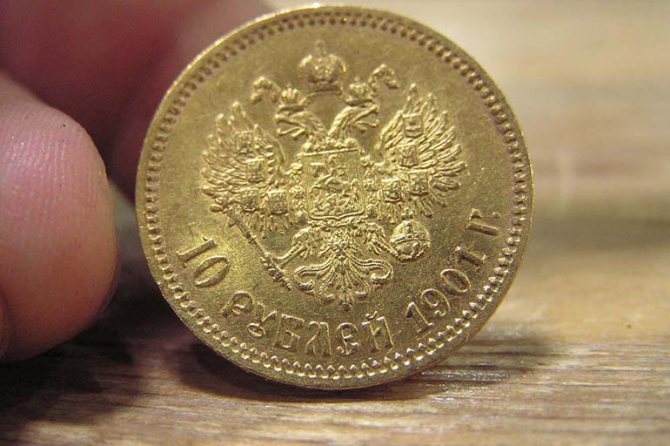
The natural abrasions of the coin indicate authenticity.
Since 1901 was over 100 years ago, the coin is unlikely to remain in good condition, so natural wear will help determine authenticity. Also, strong shine and smoothness should alert you, because... gold will tarnish over the years without polishing.
Metal characteristics
The money was minted from an almost pure 900-karat gold alloy, as shown by a special examination. Counterfeits of 10 rubles from 1901 are often made of brass, which is easy to identify by measuring and weighing the coin.
Inscription on the edge
There are frequent errors in the initials of mintzmeisters or in the form of letters engraved on the edge. Before purchasing, you should study the list of mint masters for the desired time period.
A match by name does not yet provide a complete guarantee of authenticity: it is important to carefully consider the appearance of the inscription and the execution of the letters, their width and the strength of the imprint.
Also, in a fake they often miscalculate the spelling of the word “pure”: they knock it out according to the rules of the modern Russian language “pure”.
Weight and diameter of the original coin
The real royal chervonets was issued in strict compliance with the standards. Its mass is 8.6 g, diameter is 22.5 mm. Anything that deviates from these canons should be alarming.
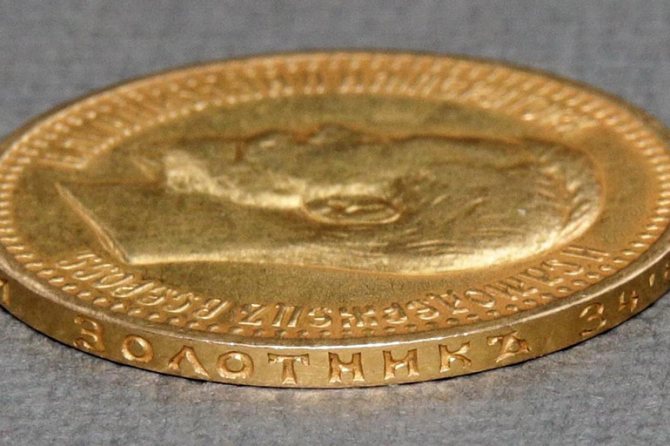
The diameter of the original coin is 22.5 mm.
Stamp quality check
During the era of Nicholas II, coins were minted. Nowadays counterfeiters prefer casting, so the structure of the counterfeit is granular and contains microscopic bubbles. The edging that goes in a wave, less detailed and sloppy stamping indicate that the gold was not made under the king.
On the original, the edge is minted neatly and clearly in the form of the Greek letter Ω.
Comparison of fake and original 10 rubles 1901
It’s worth starting to compare from the basics, i.e. from the metal from which the coin is made. The original was minted from 900-karat gold, but a high-quality copy is most often made from a real alloy. The only slight difference will be in weight and size.
The reverse of the chervonets is made accurately with great detail, especially the double-headed eagle. Fakes suffer from less precision in detail and blurred boundaries.
The obverse contains the face of the autocrat, similar to the portrait image of those years; it is harmonious and proportional. In a fake, Nicholas II does not always look like himself and is printed sloppily, the print looks careless. Many “coin producers” forget about the dot in the inscription on the right side of the portrait “AND THE AUTOCRET OF ALL RUSSIA.”
The edge is the most problematic side for counterfeiting. Therefore, the inscription is either replaced by an imitation of signs or is completely absent. If the fake is of high quality, then you should carefully study the inscription and initials of the mint master.
What were the original coins made of?
Thanks to the financial reform, the ruble was tied to gold, from which coins of 10 rubles were minted. The metal was taken of the best standard - 900, and its amount was 7.7 g of the total weight of the banknote.
Obverse appearance
On the obverse you can see the profile of Emperor Nicholas II from the left angle. In front of the portrait of the autocrat there is an inscription from bottom to top: “B.M. NICHOLAS II EMPEROR” (B.M. stands for Divine Grace). On the right side, from top to bottom, the phrase is engraved: “AND THE AUTOCRET OF ALL RUSSIA.”
Reverse image
The central place on the reverse of the coin is occupied by the Russian coat of arms of the 1883 model.
It depicts a double-headed eagle with crowns above each head, on top of which there is another larger regalia, connected with the ribbon of the Order of St. Andrew. The bird's right paw holds the scepter, and the left paw holds the orb. On his chest is the coat of arms of Moscow with a chain of the Order of St. Andrew the First-Called. The wings are decorated with the coats of arms of 8 kingdoms: Polish, Kazan, Vladimir, Novgorod, Tauride Chersonese and the general Kyiv, Siberian, Astrakhan, Principality of Finland and Moscow. The tail is made in a stylized manner, and under it there is an indication of the denomination and year of issue.
Edge of chervonets
On the edge there was an inscription: “Pure gold 1 spool 78.24 shares.” Afterwards the initials of the master of the mint were indicated. At that time it was either “F.Z.” — Felix Zeleman, or “A.R.” — Alexander Redko.
Coin value
There is no single value for all chervonets from the era of Nicholas II. The price will directly depend on the condition of the coin, the circulation and the exchange rate of gold on the world market at the time of purchase. If we take the general value, then such a coin can bring the seller from 9,000 rubles. up to several million, but for this a number of conditions must be met:
- the presence of a minted mark of the St. Petersburg mint;
- presence of a certificate of authenticity of the currency;
- good condition, no dents, scratches or any damage.
In the case of “light” chervonets, which were issued in millions of copies, their price will not be much higher than the exchange rate of the precious metal.
History of the coin
During Tsarist Russia, the issuance of gold coins as a means of payment began during the reign of Peter I. In their appearance and weight, they were completely identical to the Hungarian ducat. Initially, the denomination of such a coin was 2 rubles 30 kopecks, but the cost of producing such products significantly exceeded the denomination. Because of this, in the future they decided to make banknotes from lower quality material and increase the denomination.
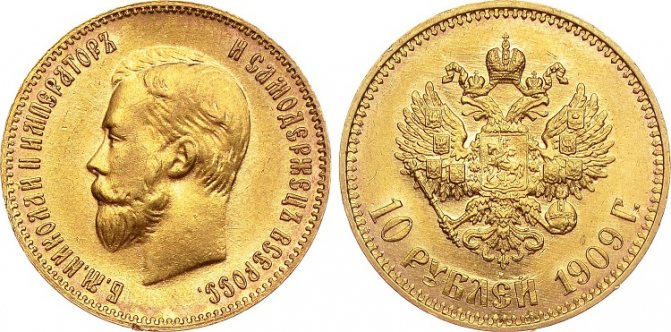
Nikolaevsky chervonets
After Nicholas II became the ruler of Russia in 1894, he began to carry out a number of reforms, including in the economic sphere. First of all, new standards were introduced for the parameters of the coin that began to be minted. And although the gold chervonets of Nicholas II used the same alloy as before (gold and copper), each pound of gold produced coins worth 317.35 rubles. This type of currency was widely used to pay for goods abroad.
The results of the financial reform were a reduction in the weight parameters of products to 8.6 grams, while maintaining the same denomination. Due to the fact that the economy of the Russian Empire of that period was actively developing, the state needed a large amount of money. Due to this, the gold chervonets coin was produced in millions of copies. In addition, at certain moments the St. Petersburg Mint, which was producing such banknotes, could not cope. As a result, its creation was additionally ordered in European countries, and in certain periods in Japan.
During the period of 1907, about 11 million coins were issued, however, already in 1911 the number of coins minted was only 500 thousand units. After this, their production was practically stopped.
Despite the officially stated number of coins issued this year, today there are about 10 million of them. It is believed that this is due to the release of these gold items by the Bolsheviks for a certain time. They are believed to have taken possession of the mint marks.
Description
The issue of the golden chervonets was carried out during the reign of Nicholas II. During this time, several types of ten-ruble coins were issued, which are worth considering in more detail.
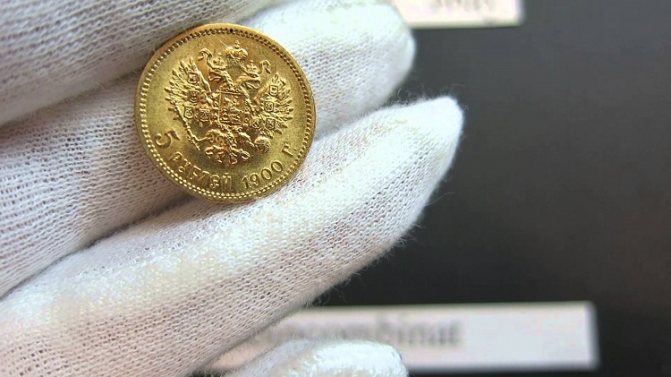
The circulation of coins was limited
Chervonets model 1899
In total, more than 27 million units of this coin were issued, which was due to the need to replenish the state treasury with money. Finances were spent on developing the national economy, as well as strengthening the country's defense potential. To make gold chervonets of this type, 900-karat gold was used. The main parameters that these coins had were as follows:
- each product had a thickness of 1.7 mm and a diameter of 22.6 mm;
- portrait of Tsar Nicholas 2, located on the obverse;
- coat of arms of the Russian Empire, made in the form of a double-headed eagle on the reverse.
Chervonets model 1906
In 1906, a slightly modified gold coin was issued. The main differences from the previous type were in minor details. So on the back side of the chervonets (reverse) the year 1906 was indicated. In addition, the abbreviation AR was minted on the edge, denoting the initials of the person who held the position of mintzmeister. At that time, he was Alexander Redko.
Imperial 1895
This type of coin was issued in the period 1895-1897. At the same time, not only the cost of the Nikolaev chervonets differed, but also the presence of a special inscription “Imperial” on the reverse. Such products were produced with a mass of 12.9 g. In total, about 375 such gold chervonets were produced during that period, which made them a rarity.
